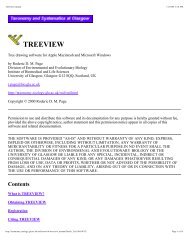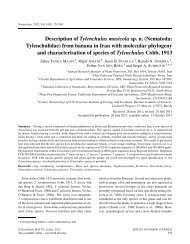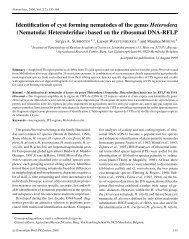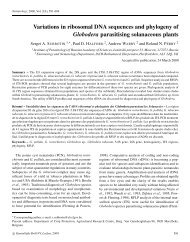Madina Rasulova Molecular Systematics of Nematodes Page 1
Madina Rasulova Molecular Systematics of Nematodes Page 1
Madina Rasulova Molecular Systematics of Nematodes Page 1
Create successful ePaper yourself
Turn your PDF publications into a flip-book with our unique Google optimized e-Paper software.
B.longicaudatus DQ672384 occurs in different places in different trees. But, nevertheless, MP and ML<br />
trees have exactly the same topology.<br />
DISCUSSION<br />
In current observation 3 such species as B.euthychilus, B.gracilis and Belonolaimus sp. were chosen<br />
in order to find out their relationship with the species <strong>of</strong> our choice – B.longicaudatus (DQ494797).<br />
Among 13 isolates 10 were identified as in-group consisting <strong>of</strong> 6 B. longicaudatus species only and 2<br />
B.gracilis, 1 B.euthychilus, and 1 Belonolaimus sp. “Manteo North Carolina”; while the rest were outgroup<br />
species comprised <strong>of</strong> Ditylenchus dispaci, Hoplolaimus columbus, and Tylenchorhynchus<br />
annulatus. According to Rau (1963), B.longicaudatus differs from B.gracilis with such morphological<br />
characteristics as having sclerotized plates in the vagina, an elongated rather than spherical metacorpus<br />
and a hemispherical rather than convex-conoid tail shape. Despite the fact that B.euthychilus looks like<br />
B.gracilis, it exhibits sexual dimorphism (males with degenerated stylet and pharynx) and does not<br />
possess a constriction between the labial region and the body.<br />
Since ITS regions are important in analysis <strong>of</strong> different populations <strong>of</strong> the same species, a number <strong>of</strong><br />
investigations were based on ITS1 and ITS2 parts for studying different populations <strong>of</strong> the genus<br />
Belonolaimus. Thereby, Cherry et al. (1997) indicated that B. longicaudatus isolates were relatively recent<br />
introduced into the state <strong>of</strong> California in comparison to Florida and South Carolina. According to<br />
morphological data, the research <strong>of</strong> Han et al. (2006) showed that females <strong>of</strong> the isolates from corn<br />
(Scotland County) and citrus (Lake Alfred) fields possess teardrop or kidney-shaped stylet, whereas in<br />
isolates from cotton field (Tifton) is typically oval. The vaginal pieces <strong>of</strong> isolates from citrus field (Lake<br />
Alfred) were the most prominent and clearly recognized among all isolates, but <strong>of</strong> those found in corn<br />
field (Scotland County) were weakly developed and not clearly recognized. Based on molecular data it<br />
was possible to conclude that all phylogenetic trees supported that the corn (Columbus, South Carolina),<br />
<strong>Madina</strong> <strong>Rasulova</strong> <strong>Molecular</strong> <strong>Systematics</strong> <strong>of</strong> <strong>Nematodes</strong> <strong>Page</strong> 12
















